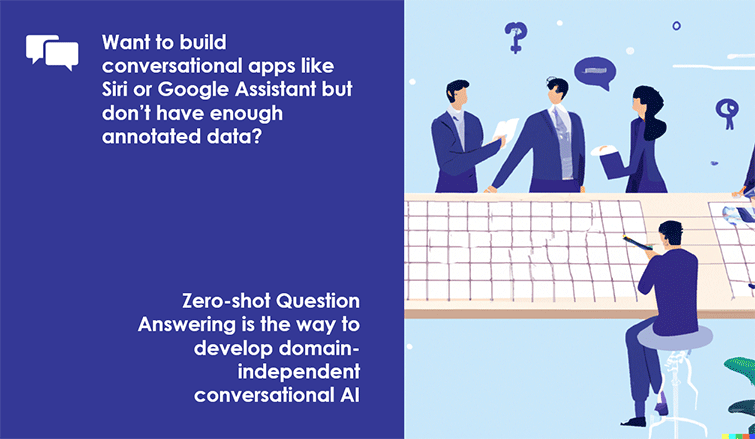- March 24, 2023
- Posted by: sadmin
- Categories: Customers

What is Open-domain Question Answering?
Open-domain Question Answering is the task of answering natural language questions without any specified predefined context. It usually requires the system to first search for the relevant documents as the context with regards to a given question from either a local document repository or Wikipedia-like document collection, and then generate the answer.
Open-Domain Question Answering Models are not restricted to a specific domain, while Closed-Domain Question Answering Models are restricted to a specific domain (e.g., legal, medical documents). Advanced Open-Domain Question Answering models make use of “Retriever-Reader” architecture.
Retriever-Reader architecture for Open-domain Question Answering

Figure 1: An illustration of “Retriever-Reader” architecture of Open-domain Question Answering system.
To know more about “Retriever-Reader architecture” click here.
How does zero-shot open-book Question Answering work?
In zero-shot open-book Question Answering, the system is not trained on domain specific documents or questions and answers, but the system can perform with a variety of document types and question and answers without training. Zero-shot open-book Question Answering model attempts to answer questions from a set of documents with no prior training or fine-tuning.
To know more about zero-shot learning click here.
Can Open-Domain Question Answering Models Answer Visual Knowledge Questions?
Zero-shot Visual Question Answering models, aim to predict with objects, questions or answers that have never appeared in training samples. As a transfer learning task, it applies closely seen instances for reasoning about unseen concepts.
Zero-shot Visual Question Answering algorithm uses Knowledge Graph and a mask-based learning mechanism, through which the existing information is well utilized to provide more accurate answers.
 Figure 2: An illustration of Zero-shot Visual Open-domain Question Answering system.
Figure 2: An illustration of Zero-shot Visual Open-domain Question Answering system.
Zero-shot Visual Question Answering is much harder than normal Question Answering, since information in the image and question is insufficient for answers that have never appeared in the training samples.
What is Closed-Book Question Answering?
Closed-Book Question Answering aims to directly answer the open-domain questions without access to any external knowledge sources, and leverages the parametric knowledge stored in large pre-trained language models. Closed-book question answering models tries to fine-tune pre-trained Language Models such as T5 or BART with Question-Answer pairs without access to any external knowledge or context.
What are the significant applications of Question Answering Models?
Customer support: In most customer support scenarios, Question Answering Models let chatbots to extract answers from existing knowledge base to answer to the frequently asked questions, and this bot can act as the “front-line agent” for handling customer queries, resulting improved agent productivity, automated resolution of queries and automatic routing of queries to the respective departments to ultimately reduce the operational cost.
Enterprise FAQ bot: Information retrieval is a challenge for enterprise employees. Internal FAQ bots are a great tool for helping employees get answers to their common questions.
Example: Microsoft’s Azure Cognitive language services, Azure OpenAI Services.
Edu chatbots: Introduced the power of conversation to online learning, through active interactions with students by encouraging and giving immediate feedback, and answer basic questions related to the subject.
Example: Cognii’s EdTech bot engages with students in real-time natural language conversation with Virtual Learning Assistant help students to learn a particular topic, get assessed on their comprehension, and receive coaching to master the concepts.
Instant and precise answers over search: Empowered with Question Answering techniques, many web search engines like Google and Bing have been evolving towards higher intelligence and have the ability to respond precisely to the questions searched and augment their search result with instant answers.
Example: Google research paper on Long Form Question Answering, Google’s LaMDA (Bard), ChatGPT.
Web-based Open-Question Answering systems: To build Web-based Open-Question Answering systems obtaining answers from online resources like Google.com and Ask.com.
References for further reading
- Retrieving and Reading: A Comprehensive Survey on Open-domain Question Answering
- Zero-Shot Open-Book Question Answering
- To implement Question Answering Models, click here.
- Zero-shot cross-lingual open domain question answering
- Zero-shot Commonsense Question Answering
- Can Open Domain QA Models Answer Visual Knowledge Questions?
- Zero-shot Visual Question Answering using Knowledge Graph
